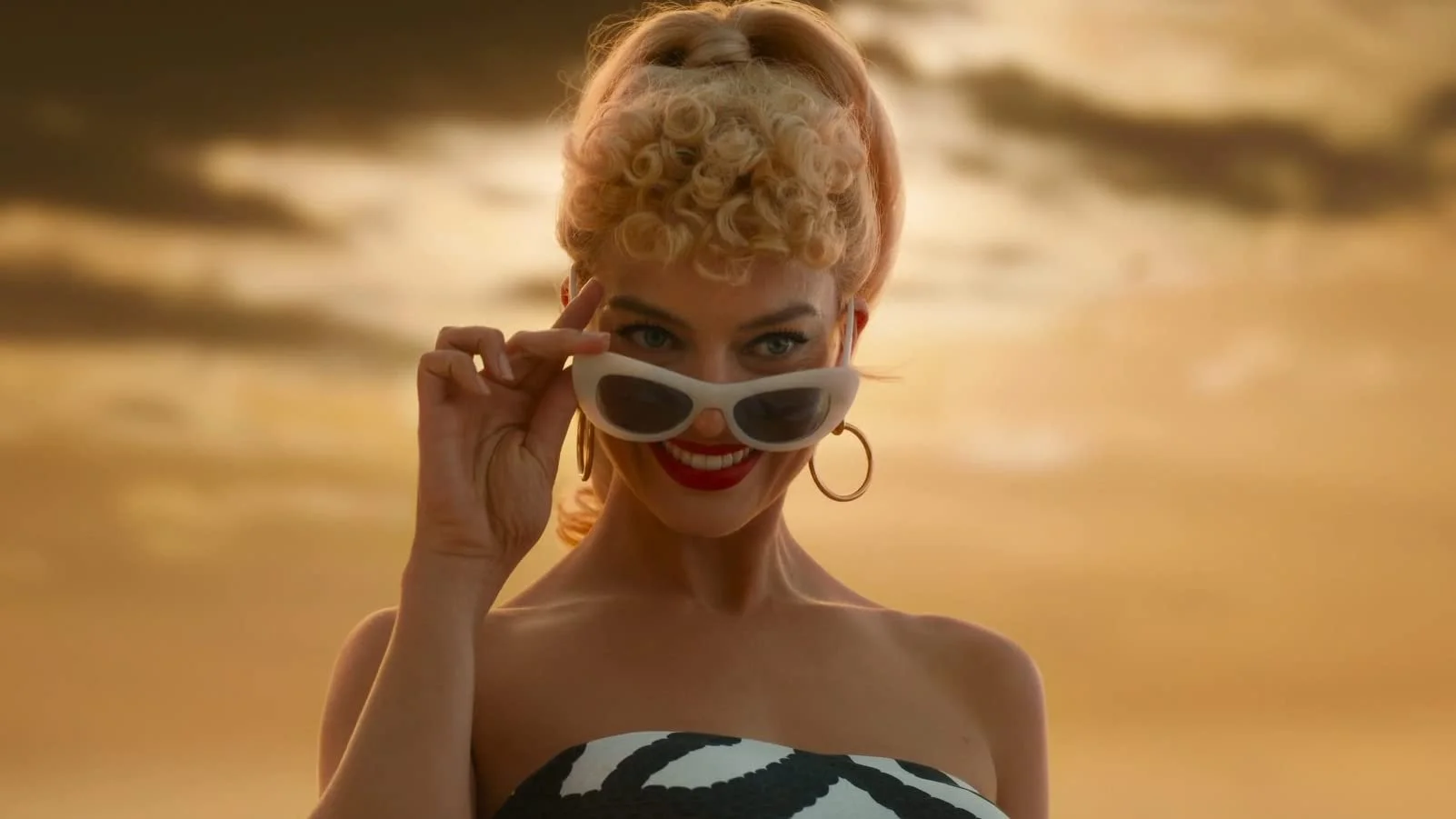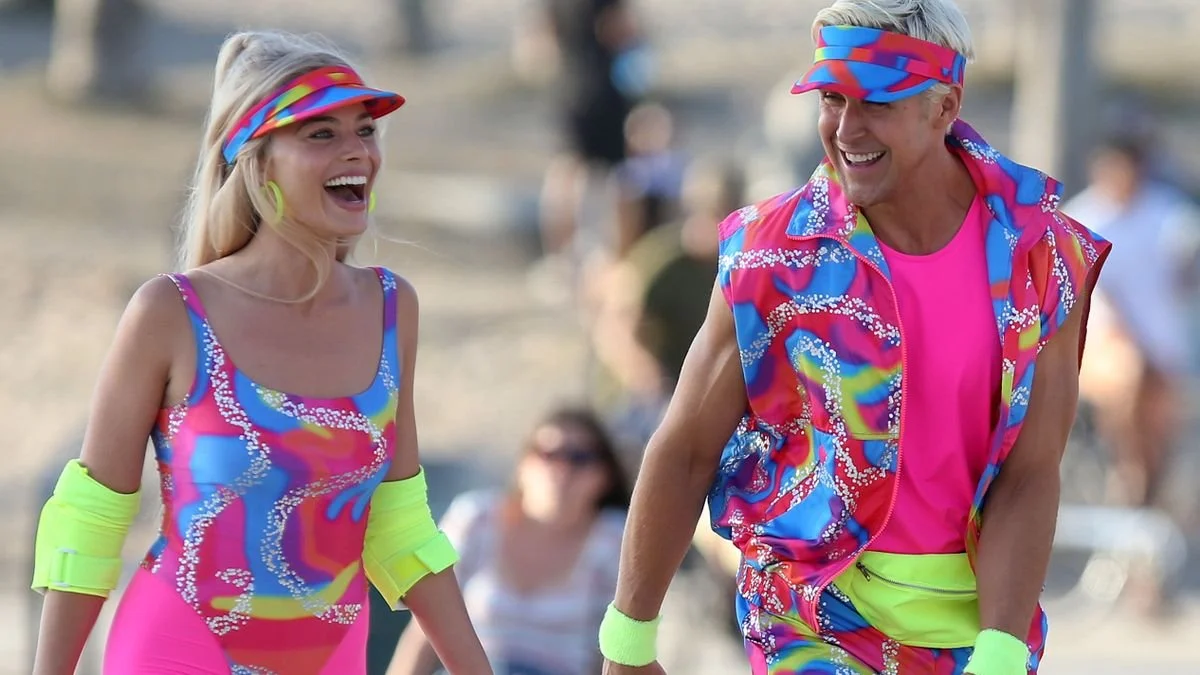Plastic Postfeminism:
Two Years of Barbie’s Legacy
This July marks two years since Barbie-mania swept the world—and since Margot Robbie stepped onto the pink carpet in full Barbie regalia, kicking off a global tour that, in a haze of consumerism, blurred the lines between film, fashion and what it meant to be feminine.
It was a moment that felt, if I'm honest, a little confusing. On the one hand, Barbie had feminist flair. It challenged what it means to be a woman, celebrated agency, and featured a cast who openly aligned with feminist ideals. (Celebrities talking about the “F word” on a global press tour? That felt new.) The film even squared up to the unattainable beauty standards the doll has long embodied. And yet, all of this came fronted by the overwhelmingly beautiful Margot Robbie, wrapped in high-gloss nostalgia, squeaky-clean imagery and pinktastic marketing. The contradiction was hard to reckon with.
Barbie has always been a controversial figure. Some see her unrealistic proportions and hyper-femininity as a symbol of the sexualised expectations placed on girls and young women. That critique hasn’t gone unheard at Mattel. Over the years, the Barbie range has expanded to include a more racially and ethnically diverse line-up. She’s taken on hundreds of roles, from doctor to astronaut, and has, in theory, been liberated from her original mould.
And yet, the beloved OG ‘Stereotypical Barbie’ remains: impossibly thin, blonde, white and polished. Barbie seems to live at the intersection of postfeminism and popular feminism, where empowerment is glossy, palatable, and often sold back to us as sparkle-coated liberation.
Earlier notions of postfeminism, especially in the 1990s, often denied the need for feminism altogether. The sentiment was: we’ve got our rights, we’re in the workplace, we are sexual because we want to be—what more do we need? It was almost a contradictory bargain. Women were granted a controlled kind of freedom, so long as they didn’t question the broader structures still holding everything in place, and looked good doing it. The result? A life lived in contradictions across our work, bodies and expectations. All perfectly summed up by Gloria’s epic monologue:
““You have to be thin, but can’t say you want to be thin… You have to be a career woman but also always be looking out for other people… …You have to answer for men’s bad behavior, which is insane, but if you point that out, you’re accused of complaining. You’re supposed to stay pretty for men, but not so pretty that you tempt them too much or that you threaten other women…But always stand out and always be grateful. But never forget that the system is rigged. So find a way to acknowledge that but also always be grateful….You have to never get old, never be rude, never show off, never be selfish, never fall down””
But Barbie didn’t deny feminism. The cast openly called themselves feminists. The film addressed the everyday slights women face: the sexism, the contradictions, the emotional labour. This wasn’t just a glossy rerun of 90s postfeminist media. There was something else going on.
Enter the concept of popular feminism, a term developed by scholar Sarah Banet-Weiser, drawing on the work of Angela McRobbie and Rosalind Gill. Popular feminism doesn’t pretend inequality is over. Instead, it acknowledges sexism and patriarchal norms but packages that critique in a way that’s media-friendly, celebrity-endorsed and brand-safe. It challenges the symptoms, but not the system. It’s feminism, brought to you by capitalism.
Or to put it more bluntly: popular feminism is what happens when corporations discover women’s issues are good for business. (Yes, we’ve seen this before. Slap a slogan on it, add some pink, and you’ve got a girl-powered goldmine.)
So, how did Barbie manage to tap into all this and go viral doing it? Barbie, directed and co-written by Greta Gerwig, is a female-first narrative that takes postfeminist contradictions and the patriarchy head-on. The film features a cast of diverse and inclusive Barbies, all living in a highly feminised, dressed-to-impress matriarchy made up of economically independent women. (YTG never had it so good.)
So what’s the catch? Well—have you seen Margot Robbie? As Stereotypical Barbie, she’s unattainably attractive, white, highly feminised, and of course, paired with a guy called Ken. To be main-character material in this world, you still have to be straight, white, beautiful and highly desirable. The film doesn’t shy away from this. In fact, it doubles down on the heterosexual paradigm: girl is the object of male desire (blatantly stated by Ken), and the world keeps spinning.
When Barbie begins to crack under the weight of her own perfection, her world literally falls apart. She malfunctions. We’ve all been there. What follows is a jolly of self-discovery that uses sharp humour to balance exaggeration and irony. It lays bare just how unattainable it is to be “everything” in a world still built for men.
One standout moment: Barbie, in head-to-toe lycra and neon rollerblades, skates through the real world with Ken and suddenly feels the crushing, invisible weight of symbolic violence. She proclaims, mid-roll, that she’s somehow conscious of herself. Meanwhile, Ken, soaking up attention for the first time, feels liberated, admired and empowered by this unexpected rush of relevance.
A lot goes down in this film. It toys with ideas of female liberation. Barbie refuses to be put back in her box—quite literally. Mattel, yes actual Mattel, nods to its sexist past while cheekily positioning itself as being in on the joke. It’s that brand-safe version of popular feminism that points out the obvious, but doesn’t always do much about it. And while Barbie’s off on her existential spiral, what does Ken do? He heads back to Barbie Land. And no, he’s not popping dinner on—he’s setting up a flat-screen, a mini bar and the patriarchy.
When it’s all nearly lost, when the absurdity and exhaustion of it all can no longer be ignored, along comes Gloria’s now-iconic monologue. A full-blown postfeminist callout that lays bare the contradictions women live every day. And something shifts. As if simply acknowledging that it’s all a bit much makes it slightly more bearable. By the end of her 114-minute journey, Barbie chooses the real world over Barbie Land. She ditches the pastel dresses for Birkenstocks, jeans and messy hair. And in a quietly triumphant moment, she heads to the gynaecologist. Rejecting the standards placed on her and embracing the real is framed as radical. The film is self-aware. It knows exactly which contradictions it’s working within. Its satirical tone lifts long-siloed feminist conversations and packages them for the mainstream.
In short: Barbie ridicules patriarchal power structures while offering a kind of optimistic, market-friendly popular feminism that, for a moment at least, felt universal.
Until, of course, Barbie hit the red carpet.
I’ll admit my naivety here. I genuinely thought, hoped, Margot Robbie would arrive at the premiere as ‘liberated Barbie’: scrunchie, Birkenstocks, jeans. But no.
On 9 July 2023, Margot Robbie, in full Hollywood glamour, captivated the cameras as she stepped onto the pink carpet at the world premiere of Barbie. Dressed in a long, sequinned gown with evening gloves, stilettos and immaculate hair and makeup, she looked every bit the iconic starlet. But this wasn’t Margot. This was Solo in the Spotlight Barbie, a replica of the 1960s doll brought to life. And it didn’t stop there. At the London premiere, she appeared as Enchanted Evening Barbie in satin and faux fur. In Seoul, Day to Night Barbie. On Bondi Beach, the original 1959 doll.
Despite the film’s attempt to liberate Barbie from these exact visual trappings, the press tour re-embodied them. The Birkenstocks were replaced with eye-watering stilettos. The messy hair smoothed to within an inch of its life. Robbie, once again, was presented to the world in full postfeminist contradiction: the empowered woman who has it all and is the epitome of male desire. Did Gloria’s speech mean nothing to anyone? It’s textbook popular feminism for corporate gain. A feminist narrative sold through the very imagery it claimed to critique. But it goes deeper. Robbie wasn’t just held to a high standard—she was held up against a plastic one. An impossibly perfect, manufactured 1960s femininity that conforms to traditional ideals of beauty and desirability.
You get to play the liberated woman, challenge the system, and then? Back in the box, smiling politely. One small step for screenkind, one giant, glittering leap back into the red carpet past. Order, it seems, has been restored. We came, we acknowledged, we made our money. Now smile for the cameras, honey. From this perspective, the marketing undoes much of the film’s groundwork. It reinstates Stereotypical Barbie not as critique, but as celebration. A glossy return to white, polished, desirable femininity, served up for mass consumption.
(And yet, in my hunt for optimism, maybe there’s something else going on. Maybe Robbie, on that pink carpet, was still playing a part. Maybe the trick was this: play the role, perform the femininity, and sneak a feminist narrative into the heart of the mainstream. Whisper the message beneath the sparkle. Package resistance as parody. And rake in the box office along the way. We all have to play our role, after all.)
Two years on, Gloria’s monologue still echoes. That relentless list of contradictions—never be old, never be selfish, never fall down—still lives rent-free in women’s heads. Because it was true. It still is. And maybe that’s what Barbie gave us: not a revolution, but recognition.
A pink, plastic mirror held up to the contradictions we live every day. But recognition isn’t change.
Barbie went viral not in spite of its contradictions, but because of them. The feminist message was softened, commercialised, and coated in just enough acknowledgement of the problem to feel real. But never threatening. Two years on, that moment feels less like liberation and more like tension. Why? Because in the media it’s okay to be feminist, so long as you smile politely, don’t ask for too much, and help turn a profit.
That’s the quiet promise of popular feminism: visibility without disruption. And it’s starting to wear thin.
If postfeminism once denied the need for feminism, and popular feminism now acknowledges inequality but leaves the system intact, then what comes next? What happens when women are asked to keep accepting contradiction after contradiction?
Because one thing is certain. Nothing stays the same. However hard structures try to fix ideas in place, culture moves on.
And for brands and businesses relying on this polished, palatable version of feminism to connect with women, here’s the truth. This isn’t authenticity. It’s a marketing tactic. One that glosses over the real, ongoing issues women face. The question now is: how long will we keep buying it?




